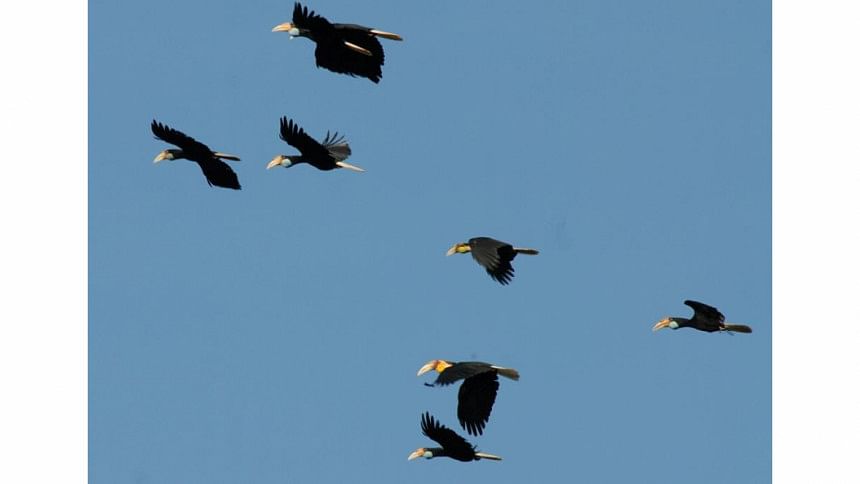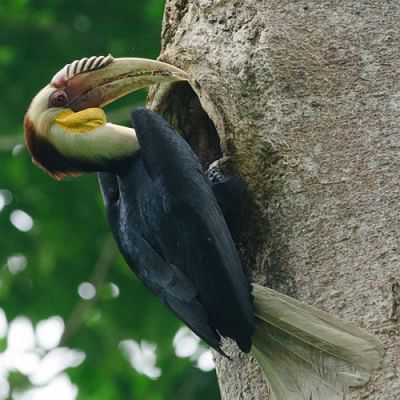Where have all the Hornbills gone

Over the past 30 years the members of the research team from Thailand's Mahidol University's "Hornbill Project" have roamed the forests of Khao Yai National Park in Nakorn Rachasima, Thungyai Naresuan Wildlife Sanctuary in Kanchanaburi and Huai Kha Khaeng Wildlife Sanctuary in Uthai Thani as part of their continuing research work on hornbills and came to the conclusion that all 13 hornbill species found in Thailand were sedentary, meaning that the largest birds in the country's forests did not venture out of the forests they lived in.
But the team led by Professor Pilai Poonswad still could not explain the disappearance of the large Plain-pouched hornbills from their habitat in Huai Kha Khaeng after the end of their breeding season in May, and then their sudden reappearance at the beginning of their breeding season the following January. They were puzzled by the unique behavior of this particular species of hornbills.
These hornbills fly to and from Myanmar and Malaysia as well.
A project to get to the bottom of the enigma was started a few years ago as one part of a multi-year research grant from PTT Exploration & Production Public Company Limited for the preservation of hornbills in general. From 2013 onward, as part of a specific research project, tiny solar-powered transmitter devices were attached on the backs of Plain-pouched hornbills. Tracking of the birds was then done using a satellite-based GPS system. By tracking the birds it was discovered that after the breeding season this hornbill species would fly over 1,000 kilometers all the way south to the Belum Forest Reserve in the State of Perak, Malaysia.

Along the way the tracked hornbills would stop in patches of forests in both Thailand and Myanmar such as Thungyai Naresuan, Khuean Srinagarindra National Park in Kanchanaburi, Kaeng Krung National Park in Surat Thani and other forests. The research team made ground checks based on the exact GPS locations along the migration routes. And at Banglang National Park in Yala Province a large flock of Plain-pouched hornbills was sighted. At the Belum Forest Reserve in Perak a sighting of a larger flock of the same species was also made.
From the data obtained it is speculated that sub-populations of Plain-pouched hornbills breed in a number of different forest locations but they then all migrate south using similar routes after the breeding season. This behavior promotes the species to breed from a larger gene pool and is thus healthier. The migratory behavior of this species of hornbills is the very first scientifically proven evidence of hornbill migration recorded anywhere in Asia and Africa where the large birds are found.
This discovery further reinforces the critical importance of natural forests along the hornbill migration routes and especially the connectivity of natural forests located in the west such as Huai Kha Khaeng and Thungyai Naresuan along the Tanasserim mountain range that also include forests such as Kaeng Krachan National Park in Petchaburi and Kui Buri National Park in Prachuab Kiri Khan. Important natural forests along the migration routes also include adjacent natural forests in Myanmar and the natural forests of Chumphon Province further south, the forest-complexes of Khlong Saeng Wildlife Sanctuary and Khao Sok National Park both in Surat Thani, the forests of the southernmost Province of Narathiwas such as the Hala-Bala Wildlife sanctuary which is connected with the natural forests of Malaysia and into the Belum Temembor forest complex.
Additional programs to be undertaken in the future to ensure the long-term survival of this migratory species of hornbills will require close cooperation between Myanmar, Malaysia and Thailand. Among activities planned are training programs to develop the capabilities of hornbill scientists in neighboring countries to look after hornbill nest sites in natural forests, as well as to implement initiatives to prevent poaching of hornbill chicks. It will be important to ensure the safety of the Plain-pouched hornbills in the forests identified by the GPS tracking system as forests along the migration routes such as the Packchan Nature Reserve in Myanmar located at the same latitude as the town of Chumphon in Thailand, the Tanintharyi National Park located across the border from Kaeng Krachan National Park in Petchaburi and the Lenya National park across the border from the town of Prachuab Kirikhan.
Such a trans-national conservation program for the long-term preservation of the Plain-pouched hornbill needs to include the preservation of natural forests along the migration routes in all the three countries involved to ensure continuity of forest areas at the frontiers between all three countries. It is also worthy to mention that the presence of hornbills in those forests along the migration routes plays a critically important role in planting trees in those forests as hornbills are efficient fruit seed disseminators.
Woraphat Arthayukti is Chairman of the Hornbill Research Foundation.
Copyright: Asia News Network

 For all latest news, follow The Daily Star's Google News channel.
For all latest news, follow The Daily Star's Google News channel. 



Comments